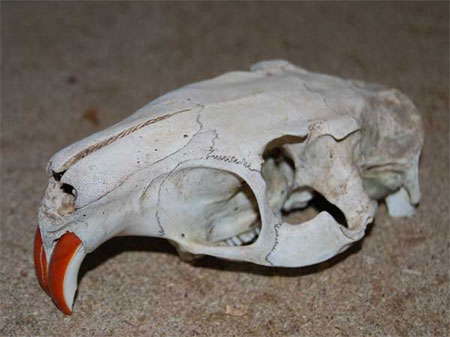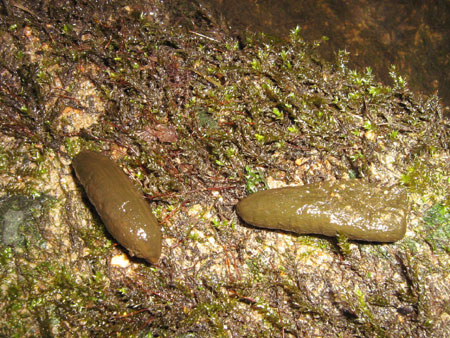Coypu Myocastor coypus Ragondin in France

Myocastor coypus
Ragondin
The Coypu is a large rodent and is the only member of the family Myocastoridae.
It is not a native species in France and was introduced from South America in the 19th century for its fur, (as were American Mink and Musk rats from North America). Following escapes and deliberate releases in the 1930’s when demand fell in the global depression they have spread to most regions of France.

Photo. Coypu in France.
Resembling a large rat or perhaps a Beaver with a rat like tail they grow to 40–60 cm in body length and have a 30–45 cm tail. They have a coarse, darkish brown outer fur with a soft dense grey under-fur, also called the nutria. They have webbed rear feet, large bright orange-yellow incisors and a whitish patch on the muzzle. Adults weigh 5–9 kg

Photo. Coypu skull showing the large bright orange-yellow incisors.
Being semi aquatic they are always in or around water, rivers, lakes, canals, marshes and ditches where they feed on a range of aquatic plants and other vegetative matter including maize and fallen fruits. They consume up to 25% of their body weight a day, a formidable quantity when combined with the 80 to 90% of the plant material wasted while feeding on the stems. Aquatic vegetation is often completely removed from a locality with the roots and rhizomes dug out for consumption. Tending to remain within a territory of about 200 metres radius they are gregarious often living in close proximity to each other in quite large groups.

Photo. Coypu, (Ragondin), excrement, France
Breeding takes place at any time of the year and with a gestation of 130 days it’s normal for a female to produce two or three broods in a year. They can give birth to as many as 12 young with an average of 6 or 7 many of which die in the first year. The young are born fully furred with open eyes and they can eat vegetation with their parents within hours of birth. Tunnels of about 20cm diameter and up to 10 metres long are dug in the bank sides, frequently with the entrance part submerged. The nest, made of dry grass and sedges, is usually subterranean in France and rarely constructed above ground in reed beds. With no natural predators in France the only population restraints are severe prolonged cold spells in winter and destruction by humans.
There is no doubt that they cause serious damage to the quality of the environment they inhabit with serious consequences for native species and the wider environment. Water quality can be seriously degraded as the natural filters provided by reeds, sedges and other bank side plants are removed and bank sides undermined. The destruction of these plants will also remove valuable sites for the birds and insects that depend upon them either for nesting, important forage or cover, and of course there is the considerable loss of some plant species. There is also a certain amount of economic damage caused to crops, particularly maize, carrots and other roots.
As an invasive introduced species eradication would be the ideal solution but this is clearly not possible and all that can be done is to strictly manage populations especially in habitats that are of great importance for other threatened or fragile native species. Cage trapping followed by humane killing would seem to be the best approach provided the traps are regularly visited as per the regulations. This allows for the release of any non target species that are captured.





